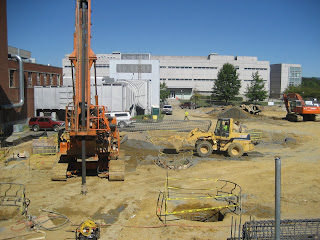I am currently an undergraduate in Building Construction at Virginia Tech. I grew up in Bluefield, WV and after graduating high school, I attended Virginia Tech for three years before I decided I wasn't ready for college. I attended college more because it was the social standard rather than it was something that I really wanted to do and I will tell you the truth, I enjoyed the social aspects of it immensely. After three years, I decided to join the Army, which was one of the best decisions I've ever made.
After three months of basic training in Fort Jackson, SC, I attended Advanced Individual Training in Fort Belvoir, VA where I studied Geospatial Engineering for 22 weeks. After AIT, I decided that I wanted to jump out of perfectly good airplanes and attended Jump School down in Fort Benning, GA for the next four weeks. It was here where I overcame my fear of heights and started pushing my body to limits that I didn't think I was capable of.
After graduating from Jump School, I was assigned to the 82nd Airborne Division located in Fort Bragg, NC. I was then assigned to 3rd Brigade Combat Team and stayed with 3BCT for the next four years, which included two tours and a total of 27 months in Iraq.
My favorite experience while in the Army (and most excruciatingly painful) was volunteering for Special Forces Assessment and Selection (SFAS) which is an intense two week initial test to become a member of the Army's Special Forces community. I can not speak much about the specifics of the training, but I will tell you that they take your body and mind to the limit. We received on average 2 and 1/2 hours of sleep per night and were given three Meals Ready to Eat (MRE) per day. The kick was that we had 15 minutes to eat them, where you have to run 5 minutes to the eating area, open up your MRE and choke down what you can in 5 minutes, and use the other 5 minutes to get back to formation. It was the culmination of things such as simply eating a meal and sleep deprivation that beat your body down after a couple of days. That combined with the physical training that lasted upwards of 20 hours per day took a toll on your mind and body. It was a humbling experience to be stripped of everything you have - your confidence, your energy, your stamina, your sleep, your food, your everything. There's a simplistic beauty to have absolutely nothing and nowhere to go but up - strangely enough I felt empowerment. And to see where you can take yourself from having absolutely nothing in the middle of nowhere and work together with a team of soldiers to accomplish something bigger than you was the best experience of my life. What I learned at Camp Mackall over those 14 days I used for the rest of my Army career and continue to use now. And you ask what the outcome was: On day 13, I couldn't walk with equipment on my back and what I volunteered for, I had to make a choice to voluntarily withdrawal from due to a left shoulder/back injury. Maybe I'll go back someday.
After five years in the Army, I decided that I was ready to move on and attend college because it was something that I wanted to do, not because everyone else was doing it. I returned from Iraq in November, 2009 and started life back at Virginia Tech as a Student in January, 2010 and here I am.














